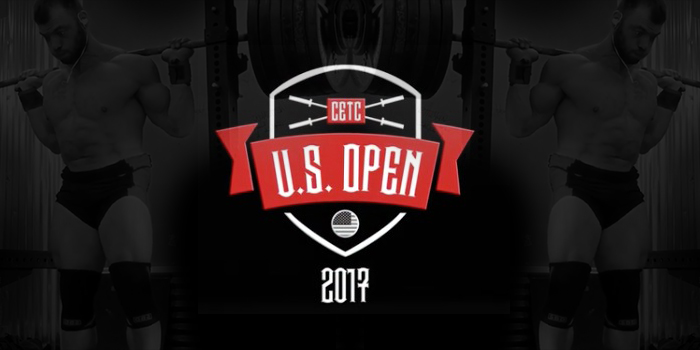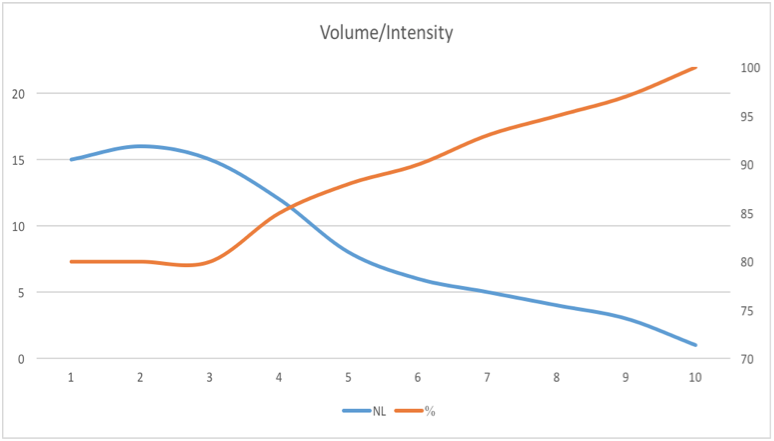
 The US Open looks damn sure to be one of the biggest meets in powerlifting history, and I’m betting that every lifter there is bringing his or her best to the platform, including myself. Obviously I’ve thought a lot about how to peak for the big day (which, for me, falls on Easter Sunday), and I’m going to share my strategy and reasoning behind it here, so hopefully, you can get some inspiration for whatever meet you’ve got coming up.
The US Open looks damn sure to be one of the biggest meets in powerlifting history, and I’m betting that every lifter there is bringing his or her best to the platform, including myself. Obviously I’ve thought a lot about how to peak for the big day (which, for me, falls on Easter Sunday), and I’m going to share my strategy and reasoning behind it here, so hopefully, you can get some inspiration for whatever meet you’ve got coming up.
A Quick Note on Weight Classes
I’m competing in the lightweight (under 181) division at the Open, even though with my frame and leverages, I’m probably going to perform better at 198. That’s because the big prize money is based on Wilks scores and the Wilks formula inherently favors heavyweight classes. Greg Nuckols has written a lot about this subject and proposed some more balanced alternatives, but in the meantime, I just couldn’t ever compete on Wilks with guys like Zahir Khudayarov and Andrey Malanichev weighing 198. If I lifted just 100 pounds less than Zahir on each lift — while weighing 75 pounds less myself — I would still lose. I’m just not playing that game.
RELATED: A Point Of Diminishing Returns
The General Approach
So I’ll be lifting at 181, and since that means I’ll be pretty lean during meet prep, I’m not going to be lifting at over 90% of my maxes for very long (not that that’s a good idea, anyway). Instead, I’ll be training with what works best for me anyways: multiple sets of low reps in the 80-90% range. I’ve always had a problem with traditional periodization methods that dedicate a good portion of a training cycle to hypertrophy with high-rep sets, because I’ve found they don’t translate quickly to low-end strength, and for me and many other advanced lifters, the absolute loads involved are still very stressful on connective tissue. Instead, I’ll be breaking the 10-week peak into three, three-week blocks: one each for restoration, strength, and peaking (with a one-week deload before the meet). Here’s how each one works:
- Restoration: This is a lower-intensity (~80%) block with moderate volume (15-20 reps per lift) designed to give me a short break from heavy training before the real push begins. I don’t usually use restoration blocks since I prefer extended offseason training anyway, but since I’m coming off a truncated meet prep cycle anyway, I need this time.
- Strength: This is a moderate-intensity block with lower volume (80-90%, 6-12 reps per lift) designed to transition from the restoration phase to the peaking phase.
- Peaking: This is a high intensity, very low volume block (>90%, <5 reps per lift) designed to prepare the body for a 1-rep max.
You’ll notice that none of these blocks is designed primarily to accumulate strength. That’s because if I hit even within 95% of my training bests at the meet, I will still be in a good position to win. I also believe that it takes more than ten weeks to build significant amounts of strength when you’re already at an advanced level. So, for most meets, I’d take a slightly different approach: something involving about 10-week long strength phase, followed by a 6- to 8-week peaking phase.
 The chart above shows my planned volume and intensity for the entire training cycle. The blue line (measured on the left Y-axis) shows volume, or the number of lifts I’ll be performing (averaged for the squat, bench, and deadlift) each week. The red line shows the average intensity for that same week. Charts like these are very helpful because you can see the degree to which your volume and intensity correlate — usually, they should be inversely proportional, so that as your training intensity increases, your volume decreases.
The chart above shows my planned volume and intensity for the entire training cycle. The blue line (measured on the left Y-axis) shows volume, or the number of lifts I’ll be performing (averaged for the squat, bench, and deadlift) each week. The red line shows the average intensity for that same week. Charts like these are very helpful because you can see the degree to which your volume and intensity correlate — usually, they should be inversely proportional, so that as your training intensity increases, your volume decreases.
The Split
Everybody knows about the importance of volume and intensity, but a lot of people forget about frequency. It’s really easy to fall into the “two upper body, two lower body” split, and that does work well for many people. Others, however, require different frequency. I do best with 3-4 bench days, 2 squat days, and 1 deadlift day per week, and I prefer not to squat and deadlift on the same day (just because those sessions take a very long time). Variation is important, too, although it’s a bit more difficult to plan that. I like to incorporate variations from the competition lifts, to give my body and mind a little rest — and remember, sometimes a change is just as good as rest! I train secondary exercises using approximately 50% of the volume of the competition lifts. For assistance, I’m a big proponent of the bang-for-the-buck approach, choosing movements that transfer directly to the competition lifts and target multiple muscle groups, rather than relying on many different isolation exercises. So, I choose one secondary exercise and one assistance exercise for each lift (I actually include two secondary exercises for bench since I train it with higher frequency). I generally rotate these every month or so, but as of right now I’ll be sticking with the same ones for this prep. Here’s how the whole thing looks:
Day 1
- Competition Deadlift: Conventional Deadlift
- Bench Secondary 1: 2-Board Bench Press
- Deadlift Assistance: Reverse Hyperextension
- Abs
Day 2
- Bench Secondary 2: Dynamic Effort
- Bench Press Bench Assistance: Dumbbell Bench Press
- Upper Back/Shoulders: 30 minutes
- Abs
Day 3
- Competition Squat: Squat with wraps
- Deadlift Secondary: Reverse Band Deadlift
- Squat Assistance: Glute-Ham Raise
- Abs
Day 4
- Competition Bench: Regular Bench Press
- Squat Secondary: Front Squat
- Abs
You’ll notice that I only have dynamic effort work programmed for the bench press. Personally, I’ve not noticed much carryover from DE training for the lower body (and remember that I lift raw). However, I think my slow descent is a weakness on my squat, and so I will perform my warmups in the usual DE way, to practice a fast but controlled descent. I have noticed great carryover from dynamic effort bench work, as long as I’m using some sort of light compensatory method. I’ll probably rely on light or mini bands for this, using about 65% of my 1RM.
Remember, I’ve spent several years figuring out exactly which variations improve my competition numbers — for most lifters, I’d recommend sticking with just a few variations for longer periods of time, to find what works for you.
Recovery & Mobility
Obviously, recovery is a huge part of meet prep — of all training, really, but it’s especially important during meet prep because of the high intensities involved. If you have the luxury of eating in a caloric surplus, that’s a great way to bolster your recovery, but I won’t. I’ll be eating maintenance, averaging around 3,500 calories per day. I’ll be trying a new approach to my macronutrient breakdown, based on how my body responded to the cut to 181 in October. It involves slightly lower protein (about 1.25 grams per pound of bodyweight) and fats, and higher carbohydrates. I won’t be carb cycling, exactly, since I’ll try to keep a fairly high carb intake on both training and off days. I will eat a bit less overall on off days, though. I’ll also maintain my active recovery and mobility work, especially massage therapy. I’m fortunate enough to be working with Tammy Hudson of Kinetix Body Science for that. Tammy and I both believe that you shouldn’t have to recover from your recovery, and her practice reflects that. I’ll also be continuing to perform low-intensity, steady-state aerobic exercise, which helps both for recovery and weight management.
Putting It All Together
If you want to incorporate some of these ideas into your own programming, here are a few recommendations:
- Start by setting goals for the meet. What do you want to squat, bench, and deadlift on your third attempts? Whatever those numbers are, you’ll to lift at least 95% as much towards the end of your training, so make sure that’s something you believe you’re capable of.
- Work backward from those goal numbers to set both your attempts and your training leading up to the meet. Obviously, you’ve got three attempts, but you might have 8, 12, or 16 weeks to train and you should structure your peaking to take advantage of the time you’ve allowed yourself.
- Make sure that, as you plan, you’re considering the overall pattern of volume, intensity, and frequency and how those variables will affect your body. To a large degree, your ability to manipulate these variables appropriately is related to your training experience, and so if you’re relatively new to the iron game, you might find it helpful to follow an already-proven training program or to work with a knowledgeable coach.
- Give yourself some space to screw up, to have bad days, and to feel under the weather without jeopardizing your mindset or your meet prep. No training cycle is ever perfect, and you need to have the flexibility to adapt to unexpected changes in your life and your body if you really want to succeed.
I know that advice might seem a little vague, but training is only part science; part of it is art, and you need the practice to master it. If you want to see how I do things, you can also always follow my progress through my coaching log.
Want More?
If this approach is one that makes sense to you, good — I believe that it’s a strong one and applicable to many trainees. Think Strong, my new eBook, covers both meet prep and off-season training, and how to tailor these ideas to your body, your own preferences, and your own schedule. Hope it helps!










1 Comment